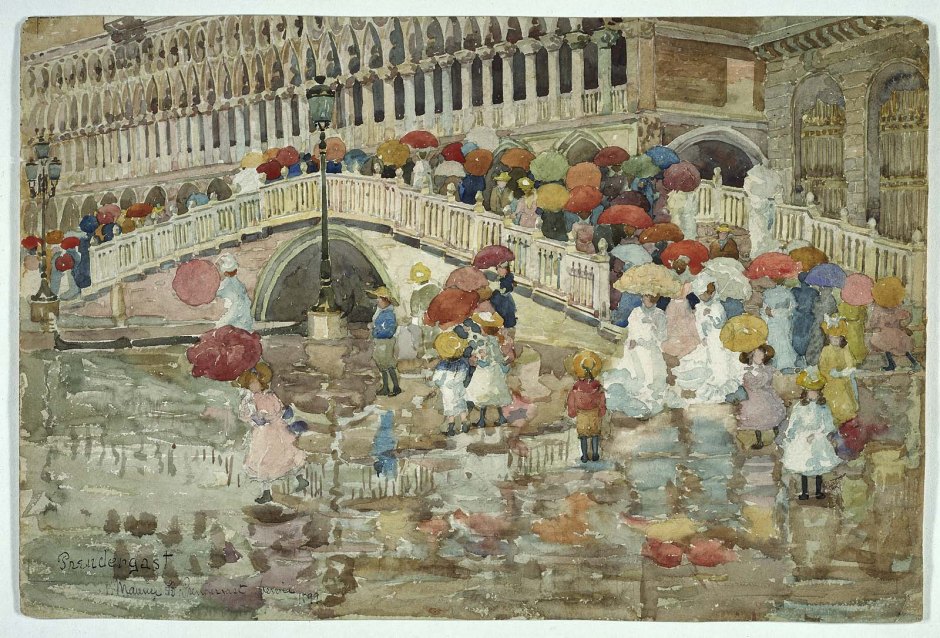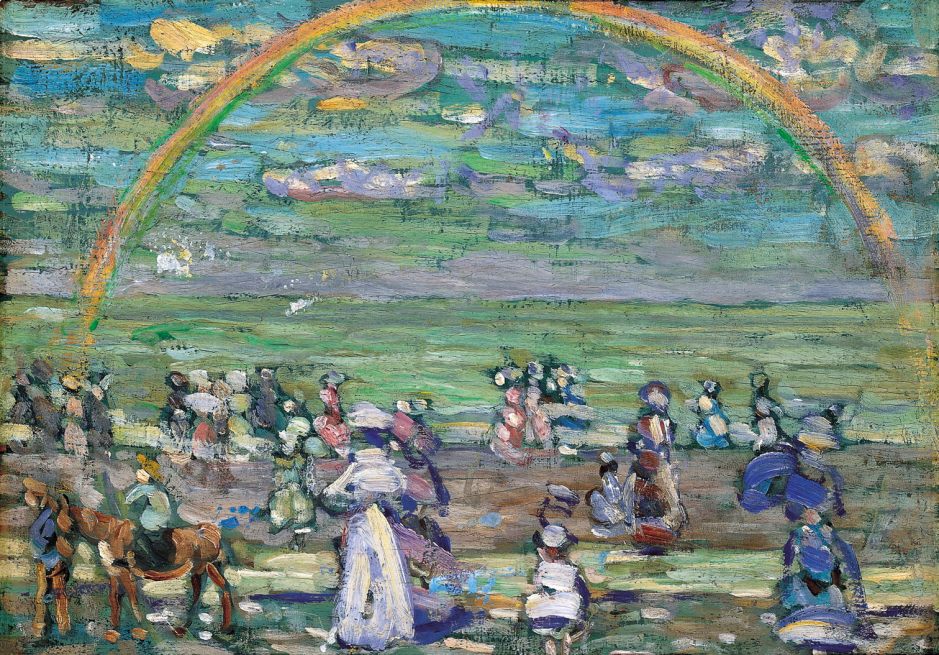A century ago today, on 1 February 1924, the American Post-Impressionist landscape painter Maurice Brazil Prendergast died in New York City.
He was born in St. John’s, Newfoundland, and moved to Boston, MA, in 1868, where he attended school before starting work as a clerk. By 1879 he was working as a commercial designer. He travelled to England with his brother Charles on a cattle ship in 1886, where he painted landscapes in Wales before returning to Boston. In the summer of 1889 he painted in Westport, Maine, then in 1891, the two brothers arrived in Paris, where Maurice studied at the Académies Julian and Colarossi until 1894, after his brother Charles had returned to Boston and become a framemaker.

This print, perhaps a monotype, of Bastille Day from 1892 celebrates the national day of France, on the fourteenth of July, and is one of his few nocturnes.

The Tuileries Gardens, Paris (1895) might have been painted shortly before he returned to Boston, and he created other works showing similar scenes in central Paris. While he was there he met Édouard Vuillard, whose influence appears to have extended to his use of colour here, and Pierre Bonnard, an addicted sketcher of street scenes in Paris.
From 1894, the two brothers lived together in Boston, where he first exhibited at the Boston Art Club in 1895. In 1897, he exhibited in New York for the first time, at the Water Color Club.

Maurice Prendergast found The Balloon on a beach in 1898. Although he may have painted this in Italy later that year, I suspect the location is on the East Coast of the USA, not far from his studio in Boston.
In 1898 he travelled to Italy, where he visited Venice, Padua, Florence, Siena, Rome and other places. His watercolours from this period are his most admired works today.

His watercolour view of the Pincian Hill, Rome from 1898 shows this hill in the north-east of the city, which isn’t one of its original seven hills, but overlooks the Campus Martius. It has long contained a series of gardens, and is named after one of the major Roman families in classical times.

He also painted many watercolours of Venice, including this of The Piazza of Saint Mark’s, Venice (c 1898-9), showing the north-east corner of the Piazza, with the facade of the north side in the background, and the Basilica on the right. Its short shadows suggest that it’s set in the early afternoon, when the Piazza is packed with people, most shown taking shelter under brightly coloured parasols. His rendering of the buildings is moderately detailed, but lacks the bravura of John Singer Sargent’s watercolours. The flags, parasols and clothing add patches of high chroma to the earth-coloured walls and pavement.

The Canal, Venice (c 1898-99) shows Riva di San Severo, and makes good comparison with Sargent’s looser watercolours of the canals, such as his Scuola di San Rocco from about 1903, below.


Towards the end of his visit, Prendergast found a jostle of Umbrellas in the Rain (1899). They’re of any colour but dark grey, and form a brilliant arc across the painting.
On his return in 1899 he started to exhibit more widely, and in 1901 was awarded a bronze medal at the Pan-American Exposition in Buffalo, NY.

He used both watercolour and pastel to paint this view of carriages in Central Park, 1900 (1900). By this time he was starting to paint in oils, and largely changed to that medium in the early twentieth century.

He painted this Rainbow on a panel in 1905.
In 1907, he sailed to France, then returned to Boston in the autumn. In 1908, he exhibited there with The Eight, a group more normally associated with gritty Ashcan realism, something he never adopted.

His Landscape Near Nahant from about 1908 shows this village situated on a peninsula in Essex County, MA.
In 1911, Maurice Prendergast followed his brother Charles to Italy, but fell ill and underwent surgery to his prostate while he was staying in Venice.

He returned to watercolour for this perfectly detailed view of the Clock Tower, Saint Mark’s Square, Venice in 1911.

At some time in the period 1910-13, he painted this Woman in Brown Coat.
In early 1912, he returned to Boston, where he joined the Association of American Painters and Sculptors, and became involved in organising the Armory Show held in New York in 1913, where he exhibited seven of his own works. He had become an enthusiast for the paintings of Paul Cézanne and Henri Matisse, and promoted their modern art in the US. He visited France again in 1914, and on his return in the autumn the Prendergast brothers moved to New York.

His oil painting of Autumn from about 1917 was made somewhere along the eastern seaboard.
In late 1923, Maurice Prendergast fell ill, and he died in New York on 1 February 1924. The Cleveland Museum of Art held a memorial retrospective in early 1926. Today the world’s largest collection of his work, and that of his brother Charles, is in Williams College Museum of Art, whose chronology I have used for this brief account of his life.
Maurice Prendergast’s paintings are distinctive, and his watercolours in particular bear comparison with others who are now better-remembered. I’de like to see them more often, and maybe alongside Sargent’s watercolours too.

